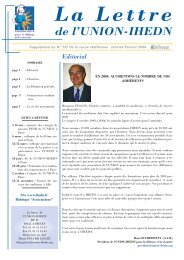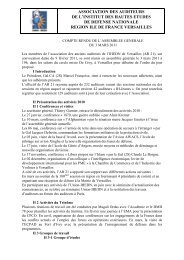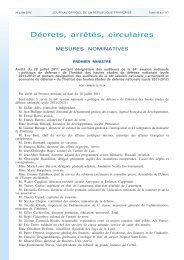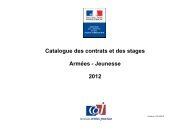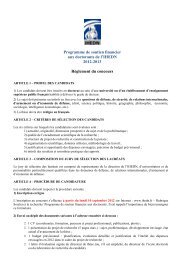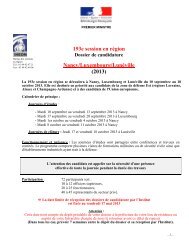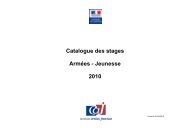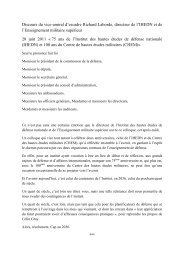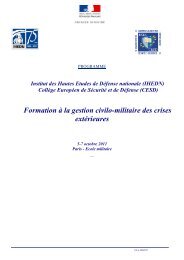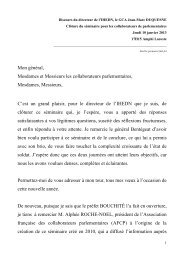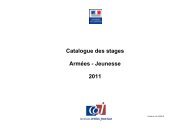Armement et développement durable : comment concilier le ... - IHEDN
Armement et développement durable : comment concilier le ... - IHEDN
Armement et développement durable : comment concilier le ... - IHEDN
- No tags were found...
Create successful ePaper yourself
Turn your PDF publications into a flip-book with our unique Google optimized e-Paper software.
45 e session nationa<strong>le</strong> 2009 I CHEArbe thoroughly analysed and recycling of materials maximised. The MoD Action Plan specifiesthat from 2008 onwards all new acquisition programs are to be established and managedaccording to sustainability princip<strong>le</strong>s – right from the initial user requirement defined jointlyby the DGA and the armed Forces.Thus the operational profi<strong>le</strong> must promote the one of simulations more environmentallyfriendly materials for training courses since they have a significant contribution to the environmentalimpact of the military systems throughout their life cyc<strong>le</strong>s. Industry now has tointegrate those concepts in the development of future systems.The equipments now in service are not <strong>le</strong>ft out of the process. All military productsconcerned have to be analysed progressively to optimize their use and remove toxic substancesuch as asbestos, cadmium or chromium and prepare for their future disposal. Inaddition to the REACh regulations forcing the EuroPean industry to declare the substancesimported or produced, Gifas has introduce an approach to identify more dangerous substances.This approach has been expended throughout Europe by ASD which defined a PLSD(Priority declarab<strong>le</strong> Substance List).The listing of these substances has been established for Naval ships and attached totheir ‘Green Passport’. The same thing is to be done by the Land and Air industries. At themoment, the list is to accompany systematically the delivery of newly ordered materials.Gifas is taking an active part in this process encouraging all suppliers to keep a record ofall the components used.However there are still obstac<strong>le</strong>s hindering the process. The armed Forces first of all wantto keep the operational capabilities at a top <strong>le</strong>vel, they fear the delays and extra costs of‘c<strong>le</strong>an weapons’. The weapon manufacturers want to remain comp<strong>et</strong>itive in a mark<strong>et</strong> thathas not valued environmental efforts y<strong>et</strong>. Finally the impact of sustainab<strong>le</strong> development canbe perceived by purchasing services as extra constraints in an already comp<strong>le</strong>x process.This trend however cannot be avoided. As a matter of fact the civilian sector has understoodthis – Snecma & EADS have followed this <strong>le</strong>ad – by carrying out applied research intothe reduction of aircraft fuel consumption, the improvement of production processes and thefinding of substitutes to the materials and substances that may soon be banned. The searchfor substitutes for p<strong>et</strong>ro<strong>le</strong>um based products is essential in the short run to guarantee freeaccess to supplies to reduce our CO 2emissions and maintain interoperability with our allies10




